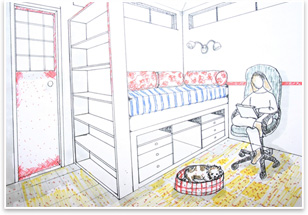
| Design Students Get Boxed In Class project proposes empty shipping containers as livable spaces
In their creative design drawings, Cañada College students showed how empty, boxy shipping containers of metal and fiberglass could be used to provide temporary housing. The durable, box-shaped units, which measure 8 by 20 feet in plan and average about 10 feet high, can be use singly or merged into multi-unit complexes. Students showed how empty, boxy shipping containers of metal and fiberglass could be used to provide temporary housing The students used room layouts and amenities found in typical homes in their unit designs, including beds, bathroom and kitchen fixtures, hardwood floors, countertops, tiles, and microwaves. A planned community unit design showcased a garden, play area, pet park, clinic, space for laptops, a social-services facility, and laundry room. One design opened up the units to the outside with patios for more living space, a loft area, and green rooftop, while another featured computerized sun-tracking solar panels. Recycled and environmentally friendly materials were part of the student designs and included bamboo flooring, countertops and tiles, non-toxic fabrics, and low VOC paints. Creative design solution for disaster relief, homelessness Cronin says goods in shipping containers arrive in port cities like San Francisco from places such as China, and then go back empty. Cronin thought the empty metal cubes could be put to better use. Her idea for the shipping container class project arose from the 100-year anniversary of the 1906 San Francisco earthquake. “After the earthquake, 3,000 cottages were built in Golden Gate Park, and in three weeks they had 3,000 people housed in them. At the anniversary event, there was a display of the old photographs, and on the opposing wall there were pictures of Hurricane Katrina showing that not much was done there. I thought that empty shipping containers could be a good class design project using a minimal amount of square footage and also be a creative design solution to disaster relief and homelessness, especially for areas like San Francisco and New Orleans with large ports. Shipping containers arrive in port cities like San Francisco from places such as China, and then go back empty “The empty containers could be purchased for $900; provide a roof, walls, and ceiling; and be used and accessed,” Cronin explains. “The students showed how you would place them on a foundation, insulate them from the inside or outside, cut out openings for windows, and stack them on top of each other. The boxes are hurricane safe, up to 140 mph. There are architects now using the shipping containers for high-end construction.” Cronin believes that with so much pre-fabricated building, a container’s rooms, ideally made from sustainable materials, could get “popped in” with kitchens, bathrooms, and bedrooms. The boxed units could be designed to include amenities like microwaves, skylights, and laptops. Containing community Cañada College offers four different design classes for a green design certificate. Cronin said she was impressed with her student’s creativity and sustainable awareness during the shipping container design project. “I was blown away.” |
||
Copyright 2007 The American Institute of Architects. All rights reserved. Home Page |
||
news headlines
practice
business
design
recent related
› Sustainability Is in the Details
› Livable Communities: A Multidisciplinary Dialogue on Designing a Sustainable Future
Shipping Container “Box Score”
Drawing and design by Kit Cunningham Golson.
Did you know that
the containers . . .
• Incorporate prefabricated, water-resistant metal panels, usually vertically corrugated, within a steel frame and roof. Steel doors are often corrugated and double-hinged
• Usually are 8 feet wide and can come in length of 20, 40, or 80 feet
• Have plywood floors
• Can be installed with electrical systems
• Have an average life of about 2-3 years, after which they are destroyed
• Usually involve a crane and truck to transport
• Fill up seaports—there are millions of empty shipping containers sitting in ports worldwide!

